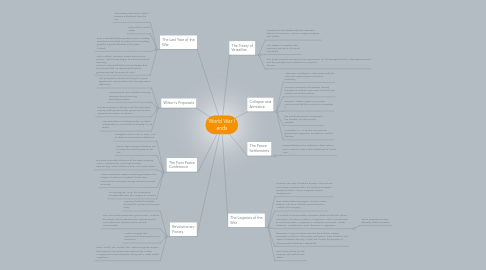World War I ends
Door Cecy Trevino


1. The Last Year of the War
1.1. The Russian Revolution, led to Russia's withdrawal from the war.
1.2. entry of the United States
1.3. Erich Ludendorff, (who guided German military operations), decided to make one final military gamble, a grand offensive in the west, it failed.
1.4. With a million American troops pouring into France, Allied forces began an advance toward Germany. General Ludendorff told German leaders that the war was lost. He demanded that the government ask for peace at once.
2. Revolutionary Forces
2.1. A group of radical socialists, formed the German Communist Party
2.2. The new Social Democratic government, crushed the rebels and murdered Rosa Luxemburg and Karl Liebknecht (leaders of the German Communists.)
2.3. Austria-Hungary also experienced disintegration and revolution.
2.4. when World War I ended, the Austro-Hungarian Empire had expired. The empire was replaced by Austria, Hungary, and Czechoslovakia, along with a state called Yugoslavia.
3. Wilson's Proposals
3.1. The proposals included reaching the peace agreements openly rather than through secret diplomacy.
3.2. His proposals also included reducing armaments and ensuring self-determination
3.3. The two enemies of liberty, could be eliminated only by creating democratic governments and a "general association of nations."
3.4. This association would guarantee "political independence and territorial integrity" to all states.
4. The Paris Peace Conference
4.1. Delegates met in Paris in early 1919 to determine the peace settlement.
4.2. David Lloyd George's platform was to make the Germans pay for the war.
4.3. The most important decisions at the were made by Wilson, Clemenceau, and Lloyd George, representing United States, France, and Great Britain
4.4. Wilson wanted to create a world organization, the League of Nations, to prevent future wars. Clemenceau and Lloyd George wanted to punish Germany.
4.5. On January 25, 1919, the conference accepted the idea of a League of Nations.
5. Collapse and Armistice
5.1. Allies were unwilling to make peace with the autocratic imperial government of Germany.
5.2. councils of workers and soldiers formed throughout northern Germany and took over civilian and military offices.
5.3. Emperor William II gave in to public pressure and left the country on November 9
5.4. the Social Democrats announced the creation of a democratic republic
5.5. November 11, 1918, the new German government signed an armistice to end the fighting.
6. The Peace Settlements
6.1. representatives of 27 victorious Allied nations met in Paris to make a final settlement of World War I.
7. The Treaty of Versailles
7.1. consisted of five treaties with the defeated nations of Germany, Austria, Hungary, Bulgaria, and Turkey.
7.2. The Treaty of Versailles with Germany was by far the most important.
7.3. The treaty ordered Germany to pay reparations for all damages that the Allied governments and their people had sustained as a result of the war.
8. The Legacies of the War
8.1. it redrew the map of eastern Europe. The German and Russian empires lost a lot territory in eastern Europe and the Austro-Hungarian Empire disappeared.
8.2. New nation-states emerged: Finland, Latvia, Estonia, Lithuania, Poland, Czechoslovakia, Austria, and Hungary.
8.3. As a result of compromises, European state was left with ethnic minorities: Germans in Poland; Hungarians, Poles, and Germans in Czechoslovakia; Hungarians in Romania; and Serbs, Croats, Slovenes, Macedonians, and Albanians in Yugoslavia.
8.3.1. These acquisitions were officially called mandates.

